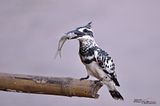One more post of my old photos taken at Doi Inthanon National Park. Apart from the 2nd checkpoint, there are lots of great birding spots within the park. The national park also holds the highest summit of the country at 2,565m above sea level. At the summit, a very important and unique ecosystem, which is the freshwater swamp forest, is formed. Unfortunately, due to mass tourism and heavy exploitation on resources, the habitats are dramatically degraded. The country's army uses the area of the highest summit as its military base and lots of precious ancient trees were sacrificed for the construction of many buildings. More and more constructions were done from year to year as being the highest summit of the country can always sell. Nowadays, tourists can drive through to the summit on a very well paved road, take photos with the sign showing 2,565m, drink Amazon coffee, buy some souvenirs and leave easily. It doesn't take more than half an hour for general tourists to sightsee the place. It's sad to see that most people don't realise how blessed they are to get such magnificent ecosystem within their own country.

 The subspecies angkanensis of the Green-tailed Sunbird (Aethopyga nipalensis) can only be found at the summit of Doi Inthanon. It is one of the few endemic species of Thailand that cannot be found anywhere else in the world. The bird is the little jewel of the summit and can be seen easily even around tourism spots. It favours nectar from the flowers planted around coffee shops and the park's headquarter.
The subspecies angkanensis of the Green-tailed Sunbird (Aethopyga nipalensis) can only be found at the summit of Doi Inthanon. It is one of the few endemic species of Thailand that cannot be found anywhere else in the world. The bird is the little jewel of the summit and can be seen easily even around tourism spots. It favours nectar from the flowers planted around coffee shops and the park's headquarter.

 What makes it different from other subspecies is the bright scarlet patch on its breast.
What makes it different from other subspecies is the bright scarlet patch on its breast. The female doesn't look anything like her husband though.
The female doesn't look anything like her husband though.
 Bar-throated Minla
Bar-throated Minla Yellow-bellied Fantail
Yellow-bellied Fantail Rufous-winged Fulvetta
Rufous-winged FulvettaNot only the sunbirds that are found regularly at the summit, there are lots of other small birds that usually present near the tourism spots. Since these birds have no experience of being hunted by human, they are mostly very tame and approachable. Many species of them often come to pick up the leftovers from tourists.
 Dark-backed Sibia
Dark-backed Sibia
 Pygmy Wren-Babbler
Pygmy Wren-Babbler


 Rufous-throated Partridge
Rufous-throated Partridge
 Dark-backed Sibia
Dark-backed Sibia Pygmy Wren-Babbler
Pygmy Wren-Babbler

 Rufous-throated Partridge
Rufous-throated PartridgeAmong all species that are found at the highest summit, one of my most favourite birds would definitely be this Rufous-throated Partridge (Arborophila rufogularis). It is one of the few species of partridge that live in montane evergreen forest. Partridges and pheasants in Thailand are normally very scarce and difficult to see, but at the summit of Doi Inthanon, a flock of this Rufous-throated Partridge is often seen behind the headquarter's kitchen. The birds often come to pick up food from the leftovers after each cook, thus can be observed quite easily at close range by birders. Unfortunately, the kitchen was reconstructed and the forest behind it has been cut down. Nobody has seen the birds since then.










.jpg)

7 comments:
They are colorful photos.
They make me feel tropical.
Those Sunbird pics are fantastic.
Again one of this fantastic set of pictures coming from another world ;-) That's a wonderful set and I love the sunbird a lot....
The Sunbirds are gorgeous. All the other birds are equally adorable too!
It's sad to see how at one point, birds and humans seem to coexist well enough, but just a slight change in the environment by humans disrupts nature upside down.
I think I could just watch those colourful sunbirds everyday and never get tired of them. :-)
That is a fscinating account of the birds up at the tourist spot. The sunbird is absolutely stunning. Let's hope something rubs off onto the tourists and they go away with a better understanding of their natural environment.
You can hear it again for the sunbirds. Beautiful as with all the others too. The place sounds wonderful but I hope it will be cared for more.
Thanks a lot everyone!
I'm waiting to go back and visit the place again in August.....
Post a Comment